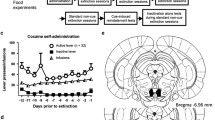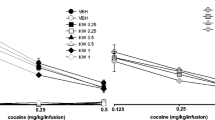Abstract
Three experiments examined the behavioural, pharmacological and neural specificity of the previously reported potentiation of responding with conditioned reinforcement following intra-accumbensd-amphetamine, by studying the effects of intraaccumbens dopamine (DA) and noradrenaline, using an acquisition of a new response procedure. In experiment 1, the effects of intra-cerebral DA infusions (5, 20, 50 µg/2 µl) were compared in four conditions: (i) intra-accumbens DA following positive pairing of the conditioned stimulus (CS) and water during training; (ii) as (i) but also following a systemic dose of the DA receptor antagonist alpha-flupenthixol; (iii) intra-accumbens DA following random pairing of the CS and water during training; and (iv) as (i) but with intra-caudate rather than intra-accumbens DA. The results showed that only with intra-accumbens DA in the positive pairing condition was there a significant dose-dependent increase in responding. In experiment 2, the effects of a higher range of doses (20, 100, 200 µg) and smaller infusion volume (5, 25, 50 µg/l µl) of intra-accumbens DA were studied, in comparison with a similar range of doses (5, 25, 50 µg/l µl) of intra-accumbens noradrenaline (NA). Only DA produced a selective, dose-dependent increase in responding with conditioned reinforcement. In experiment 3 neurotoxic lesions of the dorsal noradrenergic bundle (DNAB) using 6-hydroxydopamine producing profound (about 90%) depletion of cortical and nucleus accumbens NA levels had no effect on the increased responding with conditioned reinforcement produced by intra-accumbensd-amphetamine (3, 10, 30 µg/l µl). The results are discussed in terms of the neurochemical mediation of the potentiation of the effects of conditioned reinforcers byd-amphetamine and the role of DA-dependent mechanisms of the nucleus accumbens in reward-related processes.
Similar content being viewed by others
References
Archer T, Frederiksson A, Jonsson G, Lewander T, Mohammed A, Ross S, Soderberg U (1986) Central noradrenaline depletion antagonises aspects ofd-amphetamine induced hyperactivity in the rat. Psychopharmacology 88:141–146
Beninger RJ, Hanson DR, Phillips AG (1980) The effects of pipradrol on responding with conditioned reinforcement: a role for sensory pre-conditioning. Psychopharmacology 69:235–242
Braestrup C (1977) Changes in drug-induced stereotyped behavior after 6-OHDA lesions in noradrenaline neurons. Psychopharmacology 51:199–204
Bruto V, Beauchamp C, Zacharko R, Ansiman H (1984) Amphetamine-induced perseverative behavior in a radial maze following DSP-4 or 6-OHDA pretreatment. Psychopharmacology 83:62–69
Cador M, Robbins TW, Everitt BJ (1989) Involvement of the amygdala in stimulus-reward association: interaction with the ventral striatum. Neuroscience 30:77–86
Carter CJ, Pycock CJ (1979) The effects of 5,7-dihydroxytrptamine lesions of the extrapyramidal and mesolimbic sites on spontaneous behavior and amphetamine-induced stereotypy. Nauyn-Schmiedeberg's Arch Pharmacol 308:51–54
Cole BJ, Robbins TW (1987) Amphetamine impairs the discrimination performance of rats with dorsal bundle lesions on a 5-choice serial reaction time task: new evidence for central dopaminergic-noradrenergic interactions. Psychopharmacology 91:458–466
Costall B, Naylor RJ (1975) Differences in the nature of stereotyped behaviour induced by apomorphine derivatives in the rat and in their actions in extrapyramidal and mesolimbic brain areas. Eur J Pharmacol 31:1–16
Fibiger HC, Phillips AG (1986) Reward, motivation and cognition: psychobiology of the mesotelencephalic dopamine systems. In: Bloom FE, Geiger SR, (eds) Handbook of Physiology. The nervous system. vol4. Intrinsic regulatory systems of the brain. American Physiological Society, Bethesda, pp 647–675
Hill RT (1970) Facilitation of conditioned reinforcement as a mechanism of psychomotor stimulation. In: Costa E, Garratini S (eds) Amphetamines and related compounds. Raven Press, New York, pp 781–795
Hoebel BG, Monaco SAP, Hernandez L, Aulisi EF, Stanley BG, Lenard L (1983) Self-injection of amphetamine directly into the brain. Psychopharmacology 81:158–163
Jones GH, Marsden CA, Robbins TW (1990) Increased sensitivity to amphetamine and reward-related stimuli following social isolation in rats: possible disruption of dompamine-dependent mechanisms of the nucleus accumbens. Psychopharmacology 102:364–372
Kelley AE, Delfs J, Lang CG (1989) Enhancement of conditioned reinforcement: effects of microinjection of amphetamine into striatal subregions and of peptides into the ventral tegmental area. Soc Neurosci Abstr 460.3. Phoenix, USA
Kostowski W, Jerlicz M, Bidzinski A, Hauptman H (1977) Behavioral effects of neuroleptics, apomorphine and amphetamine after bilateral lesion of the locus coeruleus in rats. Pharmacol Biochem Behav 7:289–293
Kuczenski R (1983) Biochemical actions of amphetamine and other stimulants. In: Creese I (ed) Stimulants: neurochemical, behavioral and clinical perspectives. Raven Press, New York, pp 31–61
Lyness WH, Friedle NM, Moore KE (1979) Destruction of dopaminergic nerve terminals in nucleus accumbens: effects ond-amphetamine self-administration. Pharmacol Biochem Behav 11:553–556
Mackintosh NJ (1974) The psychology of animal learning. Academic Press, London
Mefford I (1981) Application of high performance liquid chromatography with electrochemical detection to neurochemical analysis; measurement of catecholamines, serotonin and metabolites in the rat brain. J Neurochem Methods 3:207–224
Moore KE (1978) Amphetamines: biochemical and behavioural actions in animals. In: Iversen LL, Iversen SD, Snyder SH (eds) Handbook of psychopharmacology, vol 11. Plenum Press, New York, pp 41–98
Ogren SO, Archer T, Johansson C (1983) Evidence for a selective brain noradrenergic involvement in the locomotor stimulant effects of amphetamine in the rats. Neurosci Lett 43:327–331
Pellegrino LJ, Cushman AJ (1967) A stereotaxic atlas of the rat brain. Appleton-Century-Crofts, New York
Pijnenburg AJJ, Honig WMM, Van der Heyden JAM, Van Rossum JM (1976) Effects of chemical stimulation of the mesolimbic dopamine system upon locomotor activity. Euro J Pharmacol 35:45–58
Robbins TW (1976) Relationship between reward-enhancing and stereotypical effects of psychomotor stimulant drugs. Nature 264:57–59
Robbins TW, Everitt BJ (1982) Functional studies of the central catecholamines. Int Rev Neurobiol 23:303–365
Robbins TW, Watson BA, Gaskin M, Ennis C (1983) Contrasting interactions of pipradrol,d-amphetamine, cocaine, cocaine analogues, apomorphine and other drugs with conditioned reinforcement. Psychopharmacology 80:113–119
Roberts DCS, Corcoran M, Fibiger HC (1977) On the role of the ascending catecholaminergic system in intra-venous self-administration of cocaine. Pharmacol Biochem Behav 12:781–787
Taylor JR (1984) The neural substrates of the potentiation of conditioned reinforcement byd-amphetamine. PhD thesis, University versity of Cambridge
Taylor JR, Robbins TW (1984) Enhanced behavioural control by conditioned reinforcers following microinjections ofd-amphetamine into the nucleus accumbens. Psychopharmacology 84:405–412
Taylor JR, Robbins TW (1986) 6-Hydroxydopamine lesions of the nucleus accumbens but not of the caudate nucleus, attenuate enhanced responding with reward-related stimuli produced by intra-accumbensd-amphetamine. Psychopharmacology 90:390–397
Winer BJ (1971) Statistical principles in experimental design, 2nd edn. McGraw-Hill, Tokyo
Wolterink G, Cador M, Wolterink I, Robbins TW, Everitt BJ (1989) Involvement of D1 and D2 receptor mechanisms in the processing of reward-related stimuli in the ventral striatum. Soc Neurosci Abstr 490.15, Phoenix, Arizona, USA
Author information
Authors and Affiliations
Rights and permissions
About this article
Cite this article
Cador, M., Taylor, J.R. & Robbins, T.W. Potentiation of the effects of reward-related stimuli by dopaminergic-dependent mechanisms in the nucleus accumbens. Psychopharmacology 104, 377–385 (1991). https://doi.org/10.1007/BF02246039
Received:
Revised:
Issue Date:
DOI: https://doi.org/10.1007/BF02246039




